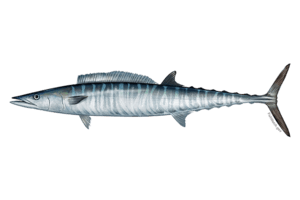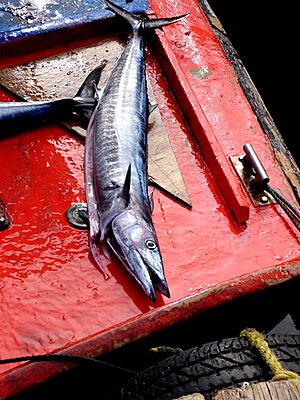Wahoo facts for kids
Quick facts for kids Wahoo |
|
|---|---|
 |
|
| A Wahoo | |
| Conservation status | |
| Scientific classification | |
| Synonyms | |
|
The Wahoo (scientific name: Acanthocybium solandri) is a type of fish that lives in warm, tropical, and subtropical oceans all over the world. It belongs to the same family as tuna and mackerel.
This fish is very popular with sports fishermen. It's known for being incredibly fast and for its delicious meat. Because of its speed and taste, it's a highly valued fish to catch. In Hawaii, the Wahoo has a special name: ono.
The meat of the Wahoo is usually white or grey. It has a delicate to firm texture and is considered very tasty by many chefs. Some people say it tastes a bit like mackerel. This makes the Wahoo a sought-after and expensive fish in seafood markets. In places like Hawaii, Bermuda, and parts of the Caribbean, local fishermen catch Wahoo mainly by trolling. Trolling means dragging fishing lines behind a moving boat. Even sports fishermen sometimes sell the Wahoo they catch. In the US, the Wahoo is often called hoo. Fishermen in the Gulf of Mexico often catch them using live bait around deep-water oil platforms during winter.
Contents
What Does a Wahoo Look Like?
The Wahoo has a long, sleek body. It's covered with tiny scales that are hard to see. Its back is a beautiful shiny blue, and its sides are silvery. It also has a pattern of irregular blue stripes running vertically down its sides. These bright colors fade quickly after the fish dies.
The Wahoo has a large mouth with very sharp, razor-like teeth. Both its upper and lower jaws look sharper than those of its relatives, the king mackerel or Spanish mackerel.
Wahoo can grow quite large. Some have been found to be up to 2.5 m (8 ft 2 in) (about 8 feet) long. They can also weigh as much as 83 kg (183 lb) (about 183 pounds). They grow very quickly and are known to be among the fastest fish in the ocean!
You can tell a Wahoo apart from similar fish like the Atlantic king mackerel or the Indo-Pacific narrow-barred Spanish mackerel. The Wahoo has a special fold of skin that covers its lower jaw when its mouth is closed. King mackerel and Spanish mackerel don't have this; their lower jaws are always visible. The Wahoo's teeth are similar to king mackerel teeth, but they are shorter and closer together.
Sometimes, people confuse the Wahoo with a barracuda. However, it's easy to tell them apart. Barracudas have large, noticeable scales and big, dagger-like teeth. They also don't have the special tail fins (called caudal keels) or the forked tail that Wahoo and other mackerel-like fish have.
Wahoo Behavior and Diet
Wahoo usually swim alone. Sometimes, you might see them in small groups of two or three fish. If the conditions are just right, they can gather in larger schools of 100 or more. Their main diet consists of other fish and squid.
Most Wahoo caught in the ocean have a tiny worm-like parasite called the giant stomach worm (Hirudinella ventricosa) living in their stomachs. But don't worry, this parasite doesn't seem to harm the fish at all.
Fishing for Wahoo
Commercial Fishing
Even though a lot of Wahoo are caught by both commercial and sports fishermen, the Wahoo species as a whole is not considered to be overfished. This is because Wahoo don't usually swim in very tight, large schools like tuna do, which makes them harder for big industrial fishing boats to catch in huge numbers.
Wahoo are often caught by accident (this is called "bycatch") in other commercial fisheries. For example, they might be caught by boats using longlines to catch tuna, billfish, or dolphinfish (also known as mahi-mahi). They can also be caught in tuna purse seine nets, especially when these nets are used around floating objects. Floating objects in the ocean often attract many different kinds of marine life, not just tuna.
Recreational Fishing
In most places where Wahoo live, they are a highly prized catch for sport fishing. They grow to a good size and are often found close enough to shore for recreational anglers. Wahoo are known for being strong fighters, especially on light or medium fishing gear. Sports fishermen admire them for their incredible speed and power during their first run after being hooked.
See also
 In Spanish: Acanthocybium solandri para niños
In Spanish: Acanthocybium solandri para niños



